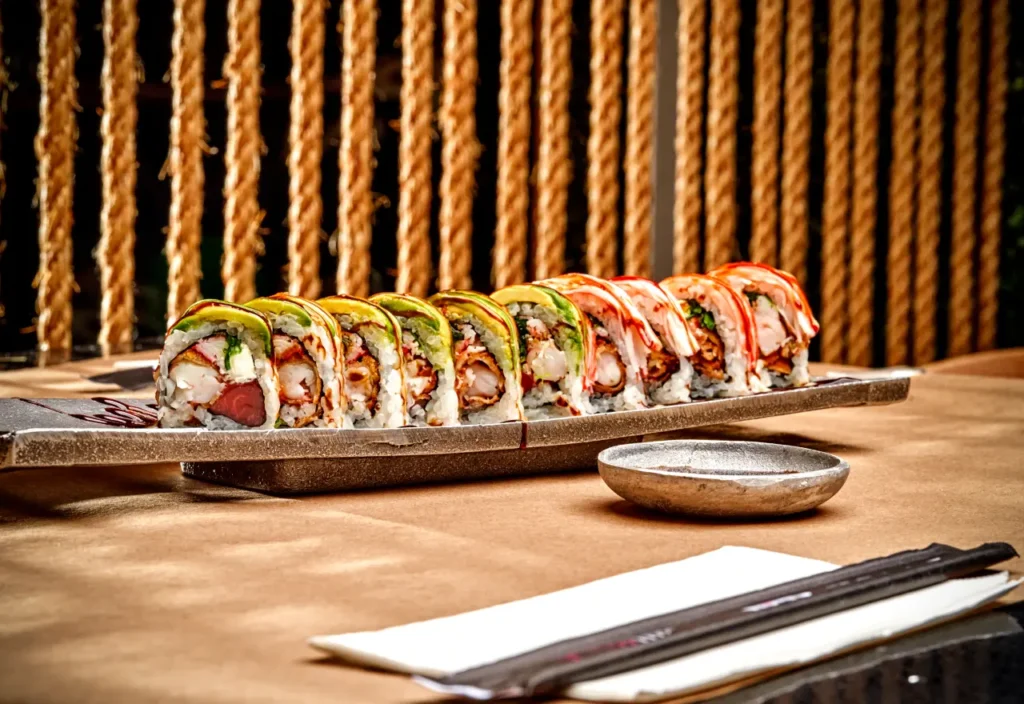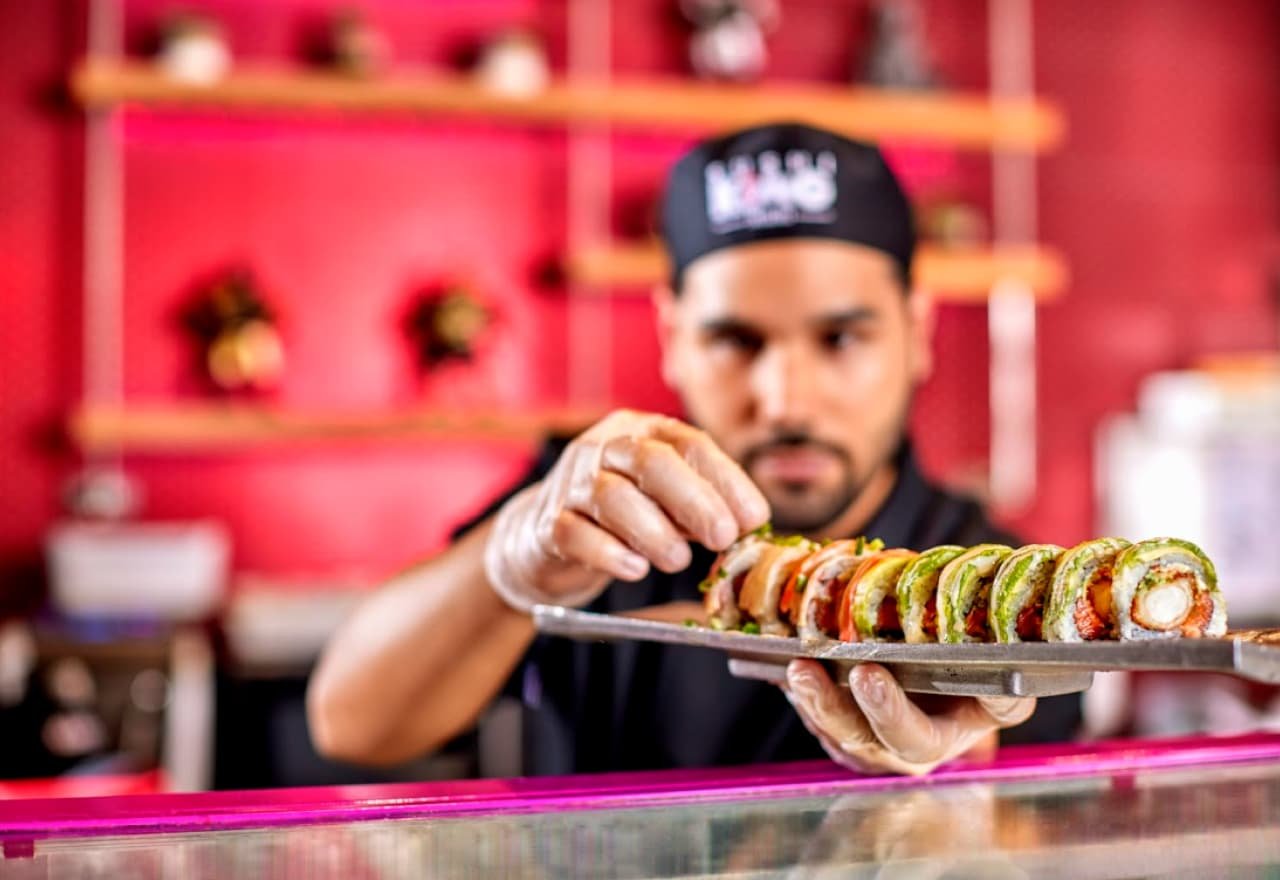Imitation Crab
Kani sushi, a beloved variation of sushi, features one of the most popular fillings in the sushi world: imitation crab. The word “kani” actually means “crab” in Japanese, but the “crab” used in Kani sushi isn’t real crab meat; instead, it’s made from a fish paste known as surimi. This fish paste is seasoned and shaped to resemble the delicate, sweet texture of crab meat, making it a cost-effective and versatile substitute. Kani sushi can be enjoyed in a variety of forms, from rolls to nigiri, and is often paired with other ingredients like avocado, cucumber, or spicy mayo to enhance its flavor.
While it may not feature real crab, Kani sushi has become a staple in sushi bars worldwide due to its mild taste and satisfying texture. Its affordability compared to traditional crab sushi, along with its ability to absorb the flavors of surrounding ingredients, makes it a crowd favorite. Whether you’re new to sushi or a seasoned enthusiast, Kani sushi offers a delicious and accessible introduction to the world of Japanese cuisine.
Tracing the Roots of Kani Sushi: A Fusion of Tradition and Innovation
Kani sushi’s origins lie within the broader history of sushi, which dates back to ancient Japan. Sushi, as we know it today, evolved over centuries, starting as a preservation method for fish. However, the introduction of imitation crab into sushi, often referred to as “Kani,” is a much more recent development. The use of imitation crab, or surimi, began in Japan in the 1970s as a response to the rising cost and scarcity of real crab. Surimi was created by processing fish, typically white fish like pollock, into a paste that mimics the flavor, color, and texture of crab meat. This made it a cost-effective and versatile alternative, and it quickly gained popularity not only in Japan but also around the world.
As sushi expanded globally, the innovation of Kani sushi took hold, with chefs incorporating surimi into various sushi creations. It became especially popular in Western countries, where it is often found in rolls like California Rolls, which typically feature Kani as one of the main ingredients. The introduction of Kani was a breakthrough for sushi, allowing for more affordable and accessible sushi experiences without compromising on taste. Today, Kani sushi continues to be a staple in sushi bars, appreciated for its mild, sweet flavor and adaptable nature.
Surimi: The Secret Ingredient Behind Kani Sushi
Surimi is a fish-based paste that serves as the foundation for imitation crab, or Kani, in sushi. Originating in Japan, surimi is made by grinding fish, typically white fish like pollock, into a fine paste. This paste is then washed to remove any strong fishy odors and impurities, leaving a neutral base that can be flavored and shaped to resemble crab meat. The resulting product is often colored with natural ingredients to give it the signature orange hue that mimics the look of real crab. Surimi’s versatility has made it an essential ingredient in various seafood products, particularly in sushi, where it is used to create Kani, the imitation crab filling.
The process of creating surimi is an art that combines both traditional and modern techniques. Surimi has been used for centuries in Japan, originally as a method of preserving fish before refrigeration. However, over time, it evolved into a more refined product, becoming a popular substitute for expensive or hard-to-find seafood like crab. Today, surimi is not only essential for making Kani sushi but is also found in a variety of processed foods such as seafood salads, imitation lobster, and fish sticks. Its ability to mimic the texture and taste of real crab, while being more affordable and sustainable, makes it a go-to ingredient in both traditional and contemporary sushi dishes.
Crafting Kani Sushi: A Step-by-Step Guide to Perfecting Imitation Crab Rolls
Making Kani sushi is a simple yet precise process that involves carefully assembling ingredients to create a flavorful and satisfying dish. While there are variations, the core process remains similar across different types of Kani sushi. The star ingredient, imitation crab made from surimi, is typically prepared in advance, and then combined with other fresh elements to create the perfect sushi experience. Whether in a roll or as nigiri, the process emphasizes balance and texture to ensure the imitation crab shines through alongside other ingredients.
Here’s a breakdown of how Kani sushi is typically made:
- Prepare the Sushi Rice: The foundation of any sushi dish is the rice. It’s seasoned with a mix of vinegar, sugar, and salt to create the perfect balance of flavors.
- Prepare the Kani (Imitation Crab): The surimi is often shredded or sliced into bite-sized pieces. For rolls, the Kani may be placed in long strips, while for nigiri, small portions are gently pressed on top of the rice.
- Assemble the Sushi Roll (for Kani Rolls): A sheet of nori (seaweed) is placed on a bamboo mat, and a thin layer of sushi rice is spread evenly on top. The prepared Kani is laid in the center, often paired with other fillings like avocado or cucumber, before rolling it tightly into a cylinder.
- Form Nigiri (for Kani Nigiri): A small mound of sushi rice is shaped with your hands, and a piece of Kani is gently placed on top. Sometimes, a small dab of wasabi is added between the rice and the Kani for extra flavor.
- Serve and Enjoy: Once assembled, the sushi is ready to be served with soy sauce, pickled ginger, and wasabi for that authentic sushi experience.
Exploring the Many Faces of Kani Sushi: Delicious Variations to Savor
Kani sushi has become a versatile and beloved dish, with several variations that cater to different tastes and preferences. One of the most popular forms is the Kani roll, where imitation crab is paired with other fresh ingredients like cucumber, avocado, or spicy mayo, all wrapped in a sheet of nori and sushi rice. The California Roll, which often features Kani as its star ingredient, is one of the most famous sushi rolls in the world. It has helped introduce Kani sushi to international audiences and remains a favorite on many sushi restaurant menus. The mix of creamy avocado, crisp cucumber, and savory Kani creates a balance of textures that makes this roll a go-to for many sushi lovers.
Another popular variation is Kani nigiri, where a small mound of seasoned sushi rice is topped with a slice of Kani. This simple yet elegant presentation allows the imitation crab to shine without being overshadowed by other ingredients. Kani can also be found in specialty rolls, such as the Spider Roll or Tiger Roll, where it’s combined with other seafood like shrimp tempura, eel, or spicy sauces for a more complex flavor profile. For those looking for a more decadent twist, some sushi chefs top Kani sushi with crunchy tempura flakes or a drizzle of eel sauce. No matter the variation, Kani sushi continues to be a versatile and tasty option for sushi enthusiasts around the globe.
The Flavor Profile of Kani Sushi: Sweet, Mild, and Delightfully Satisfying
The flavor of Kani sushi is uniquely mild and sweet, making it an ideal choice for those new to sushi or those who prefer subtler tastes. Since the main ingredient, surimi, is made from fish like pollock, it takes on a delicate flavor that closely resembles real crab meat but without the briny undertones of the ocean. The imitation crab has a smooth, slightly firm texture that mimics the tenderness of crab, providing a satisfying bite. When paired with the vinegary sushi rice and other fresh ingredients, such as avocado, cucumber, or spicy mayo, the Kani brings a balanced sweetness that complements the dish without overwhelming the palate.
In addition to its mild sweetness, Kani sushi’s flavor profile benefits from the contrasting textures and seasonings that accompany it. The sushi rice provides a slight tang from the vinegar, while the seaweed adds a savory umami taste, enhancing the overall experience. The subtle crunch of vegetables like cucumber or the creamy texture of avocado adds an extra layer of flavor that pairs perfectly with the tender Kani. Whether served in a simple nigiri form or as part of a more elaborate roll, Kani sushi offers a light and refreshing taste that can be enjoyed by sushi lovers of all ages.
Kani Sushi in Modern Sushi Culture: A Global Favorite
Kani sushi has firmly established itself as a staple in modern sushi culture, transcending its Japanese origins to become a favorite worldwide. In many countries, particularly in the United States and Europe, Kani sushi is often found in popular rolls like the California Roll, helping to introduce sushi to a broader audience. Its mild flavor, versatility, and affordability make it an accessible option for people unfamiliar with traditional raw fish sushi. The widespread popularity of Kani sushi has made it a go-to choice in both high-end sushi restaurants and casual sushi bars, often seen as a gateway to the world of sushi for newcomers. Over time, Kani sushi has evolved, with chefs adding innovative touches like spicy sauces, tempura crunch, and even fusion-style rolls to keep it fresh and exciting.
Beyond its place in sushi rolls, Kani sushi has also found its way into home kitchens and food culture at large. With the rise of DIY sushi kits and YouTube tutorials, more people are experimenting with Kani sushi as an easy-to-make, budget-friendly option that doesn’t compromise on taste.
The dish’s ability to cater to various dietary preferences, such as being a seafood alternative for those who don’t consume raw fish, has made it particularly appealing. Today, Kani sushi remains a beloved and versatile dish in modern sushi culture, constantly being reinvented and enjoyed by sushi lovers around the globe.
Kani Sushi: A Flavorful Journey Worth Exploring
Kani sushi has carved a unique and enduring place in the world of sushi. With its mild, sweet flavor and versatile applications, it continues to be a favorite in sushi bars around the globe. Whether served as part of a roll or as nigiri, Kani sushi offers a delightful experience that appeals to both sushi enthusiasts and newcomers alike. The affordability and creativity it allows in sushi preparation have ensured its lasting popularity, evolving to meet modern tastes and preferences.
Sushi KONG stands out as the premier choice for those looking to indulge in the best sushi experience in Miami. With a menu that embraces the classic and innovative, Sushi Kong offers an array of fresh, expertly crafted sushi, including delicious Kani rolls and more. Visit our website to explore our full menu and discover why we are the top sushi destination in Miami!




